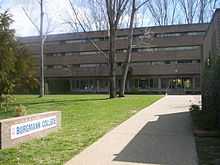Dirk Bolt
| Born |
1930 Groningen |
|---|---|
| Nationality | Dutch |
| Alma mater |
Delft University of Technology |
| Buildings |
Christ College, Hobart |
Dirk Bolt (born 1930) is a Dutch-born architect who is best known for his post-Second World War Australian modernist architecture and his later career as an academic and consultant that applied sustainable, equitable and humane principles to town planning.
His most notable buildings include the Sandy Bay Campus buildings of Christ College at the University of Tasmania and the Murray Street State Offices in Central Hobart.[1]
Professional life and education
Dirk Bolt was born in Groningen in 1930.
He commenced his studies in architecture at the Delft University of Technology, but moved to Australia in 1951, and finished his qualifications as an architect and town planner at Hobart Technical College.[2] He designed many innovative residential and commercial buildings in Hobart and Canberra. In Canberra, where he worked between 1964 and 1971, he also consulted to the National Capital Development Commission, providing advice on planning of the growing capital. The Australian Institute of Architects (ACT) is in the process of publishing a monograph on his architectural and town planning work in Canberra.[3]
In the 1970s, he worked for international development organisations in Africa and Asia, including the UN Office of Technical Cooperation. He consulted to many agencies and governments on planning, development and sustainability.[3][4]
He was appointed Senior Lecturer in Urban Design at the University of Auckland, where he received a PhD in town planning in 1984.[3][4] His thesis was concerned with sustainable, equitable and humane town planning. This is also reflected in his later work that includes low-energy aspects of planning, providing tools for planning in mega-cities in developing countries, and affordable residential modular construction using timber.[4] In 1987, he returned to the Netherlands and later became professor and head of Urban Planning at the University of Twente.[3]
Dirk Bolt is an honorary fellow of the Australian Institute of Landscape Architects and past president of the ACT division of the Australian Planning Institute.[4] Currently, he lives in Scotland.
Notable buildings

Christ College, University of Tasmania (1961-62)
Commissioned to accommodate the relocation of the University of Tasmania to Sandy Bay, Christ College was the first residential college to be completed on the new campus. It could be regarded as a good example of Tasmanian modernist architecture, and in its style similar to Säynätsalo Town Hall designed by Alvar Aalto.[5] Situated on a steep slope, "Bolt created a virtual hill town of visually different buildings grouped around a garden court" using materials that were designed to mature with time, such as natural concrete blocks and untreated timber.[6] The building received the Australian Institute of Architects 2011 Enduring Architecture Award (Tasmania). [7]
Murray Street State Offices, Hobart (1966-69)
Completed in 1969, 10 Murray Street, as the Hobart building is commonly known, has been described as a unique example of Australian Brutalist architecture that was common in the 1960s.[8] It is a multi-storey office building with an external reinforced concrete frame and recessed windows. Recently earmarked for demolition, a petition was started to save the building and to consider refurbishment. [8][9]

Burgmann College, Australian National University, Canberra (1970–71)
Given the success of the Christ College buildings at Sandy Bay, Dirk Bolt was commissioned to design Burgmann College, a residential mixed-sex college at the Australian National University. Even though originally intended to consist of four wings around a central courtyard with attached service buildings, only two wings were completed to form an L-shape building. The college building could be regarded as a Japanese inspired design combined with Dutch pragmatism using sliding doors and windows similar to shōji screens, recessed horizontal fenestration, and a restricted palette of materials.[6]
References
- ↑ Calder N (1999). Significant Tasmanian architecture of the 20th century. In: Australian Bureau of Statistics (1999). Tasmanian Year Book 2000 (Cat. No. 1301.6). Retrieved 18 November 2012.
- ↑ McNeill B and Ratcliff E (2006). Dirk Bolt. Centre for Tasmanian Historical Studies. Retrieved 17 November 2012.
- ↑ 3.0 3.1 3.2 3.3 Australian Institute of Architects. Biography: Dirk Bolt. CAPITheticAL. Big Ideas. Big Future. A design ideas competition for a hypothetical Australian capital city. Retrieved 18 November 2012.
- ↑ 4.0 4.1 4.2 4.3 Australian Capital Territory (2008). Heritage (Decision about Provisional Registration of 1 Astley Place, Garran) Notice 2008 (No 1) (Notifiable Instrument NI 2008 – 104).
- ↑ King S (2011). Life Cycle: Christ College. Australian Design Review. Retrieved 17 November 2012.
- ↑ 6.0 6.1 Goad P (2001). The Design and the Building. In: Burgmann College (Australian National University) (2001), The place to be: Burgmann College 1971-2001.
- ↑ Australian Institute of Architects (2011). 2011 Tasmanian Architecture Awards: Full List of Winners. Australian Institute of Architects Media Release. Retrieved 18 November 2012.
- ↑ 8.0 8.1 Petition started to save 10 Murray Street. Australian Design Review. Retrieved 18 November 2012.
- ↑ Stedman M (2009). Architect pleads for building. The Mercury (Hobart). Retrieved 18 November 2012.